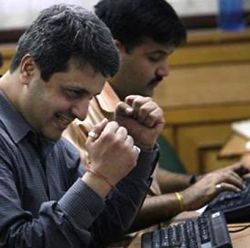India's equities are considerably underweight, especially when one adjusts for demographics and expected returns, says Akash Prakash.
 There is growing concern among investors about whether India as a market is over-owned and over-hyped.
There is growing concern among investors about whether India as a market is over-owned and over-hyped.
Reports show that in surveys of emerging market investors, India emerges as a big overweight market.
One report, in fact, shows India to be not only a double overweight market in emerging market portfolios, but also the largest active bet.
If these surveys are anything to go by, one cannot expect continued strong inflows from global investors; at some point, investors will take profits.
As a result, investor appetite for Indian equities will be limited.
After having spent some time talking to investors and allocators globally, I think one should question the notion that India is a consensus overweight market.
Yes, it is true that many global macro funds have positions in India and have invested in both equities and fixed-income securities.
It is also true that many global funds have made big bets on India's private sector banks.
However, numerous Asia-based funds have had almost no exposure to India; they have been happily absent from the country for the last few years, and that hasn't hurt their performance.
There is, however, an increasing realisation that this could be the beginning of an extended period of outperformance for India, and that they cannot afford to miss it entirely.
I would, therefore, expect flows from many of these Asian funds; the potential cost of being underweight on India seems too high.
The same comments hold true for smart real money investors in the United States, most of whom run very long-term, almost permanent, capital pools.
At the same time, it is premature - and incorrect - to think that everybody in this group has already made their India bet.
Most of the long-term real money investors are yet to fully make their move. Although they have money invested in India, it is by no means at the level of exposure they desire.
They were unwilling to commit before the Lok Sabha elections, waiting instead to see how this would pan out.
Most of them fully understand the implications and significance of the election results; many are, in fact, willing to bet that India is poised to get back on the growth track.
Some, on the other hand, would want to wait and see further evidence that the new government will make the right moves; but even they are positively biased and willing to commit capital if the National Democratic Alliance stays true to the reformist economic agenda.
Many see this as India's Thatcher moment; they fully appreciate the impact that a popular leader with a coherent economic strategy and mandate for change can have.
Most of these large investors have much more money in country-specific mandates in Brazil and China than they do in India.
Given how much India has disappointed on multiple fronts over the last few years, most felt it was not worthwhile to have a country-specific mandate for Indian equities.
As this election is increasingly thought to be an inflection point for India's economic prospects, one could expect investors to be more willing to look at India-specific mandates and put a structural overweight on the country.
Even one year of 30 per cent outperformance (as witnessed year to date) can change the historic long-term performance numbers, thereby forcing consultants to change their recommendation that India can be safely avoided.
What helps India's case is the fact that growth is currently very difficult to come by in the world.
Any country that can accelerate and finally deliver the promise of an extended run of seven per cent economic growth will trade at a premium.
Most of the other large emerging market countries have structural challenges.
Against this backdrop, India clearly looks better positioned than most markets to deliver strong financial returns for investors.
One is likely to see a lot of new money flowing into India from these large pools of long-term capital.
It may not chase the markets and will use pullbacks, but it will come only as long as the new government delivers on its promises of economic development and governance.
India is also far from being the flavour of the season; it is only now that hedge funds and macroeconomic panels have started to mention the country as a good trade opportunity.
We are yet to see bullish macroeconomic reports about the structural case for India. Moreover, most global funds have not visited India for the last few years.
Clearly, this is not 2007, at least not yet.
On the flows front, even though I think foreign flows into India will remain strong over the coming years, the real story will be that of domestic investors.
Few people recall that in 2007 and 2008, flows from domestic investors outdid those from foreign institutional investors (FIIs).
In 2007, domestic institutions invested $6.4 billion compared to $5.8 billion by FIIs; in 2008, domestic institutions invested $17.7 billion as against $13.1 billion by FIIs.
However, between 2004 and 2010, while FIIs invested $61 billion into India, domestic institutions put in $46 billion (source: Motilal Oswal). Even so, it is a fallacy to say that India has always been totally dependent on foreign flows to drive its capital markets.
That has been the unfortunate truth over the last four years; between 2011 and 2014, domestic investors gave up - domestic institutions sold equities worth $27 billion, while FIIs pumped in $73 billion.
Now, as domestic investors regain confidence, alternative asset classes - such as gold and property - stagnate and financial savings rise as the Reserve Bank of India ensures positive real interest rates, one should expect strong inflows from domestic institutions into equities.
This, not foreign flows, will be the real driver of this bull market.
India's equities are considerably underweight, especially when one adjusts for demographics and expected returns.
We have to fix the distribution architecture for financial savings by striking the right balance between regulations and incentives.
There is no reason why, over the coming years, domestic institutions should not be investing $10 billion ever year in equities.
Since we are a capital-short economy, we need all the capital flows we can get - whether they are domestic or foreign. The prospects look good for both.
At the same time, many investors think this is India's last chance; if we muck it up again, we will not be forgiven for a long time.
The stars are aligning - it is hoped that India will seize this opportunity.












 © 2025
© 2025